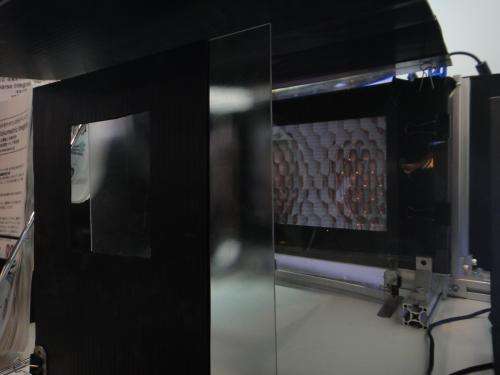November 7, 2011 report
Prototype uses multi-lens display for 3-D depth (w/ video)

(PhysOrg.com) -- Numerous 3-D displays that went on parade at last month's CEATEC 2011 in Japan touted glasses-free features, but one 3-D display presentation used a technique of special interest. Researchers at Tsukuba University in Japan showed a 3-D display prototype using multiple layers of lenses for focal depth and enhanced depth perception in the 3-D image. When objects at the front are in focus, those at the back are blurred. When you view objects at the back, those in front are blurred.
The core feature of this display is that it reproduced focal depth. According to the video notes, the display is available in two versions. In one, the joins in the lens array are smooth. When you move your head, the picture appears smoothly. This display has seventy-six viewpoints, reproducing natural motion parallax. The other version has fifty viewpoints and higher resolution, achieved by lenses with non-aligned centers.
While ordinary glasses-free 3D displays only have parallax horizontally, this one has, in the case of fifty viewpoints, ten horizontally and five vertically. The picture changes not only when you move horizontally but also when you move vertically. In other words, a feature of this display is that you can see a 3-D picture when lying down with your head horizontal. The sticking point is resolution.
"The resolution of this display is about 200 x 200, so it's not sufficient yet," said Professor Hideki Kakeya. “But one feature of this system is that, if you don't have a single high-resolution panel, you can use an array of small panels, with lenses arranged so as to hide the bezels. Doing that costs money, but in principle, it isn't very difficult to increase the resolution.”
In carrying out his research, Kakeya's target base has not been the entertainment industry but rather how this technique might play out in 3-D scenarios for specialized purposes.
His target is the realtime interaction scenario where the viewer needs to perceive 3-D space instantly -- robot tele-operations, 3-D drawing and surgery simulations are examples.
The main application for the CEATEC display is reported as the picking up of objects by remotely operated robots. That exercise, like the others, would need depth to be shown accurately.
Beyond CEATEC, Prof. Kakeya’s work focuses on precise depth perception using coarse integral volumetric imaging (CIVI). This is defined in a recent paper as 3-D display technology combining multi-view and volumetric solutions by introducing a multilayered structure to integral imaging.
More information: via Diginfo
© 2011 PhysOrg.com



















